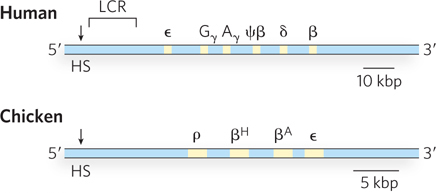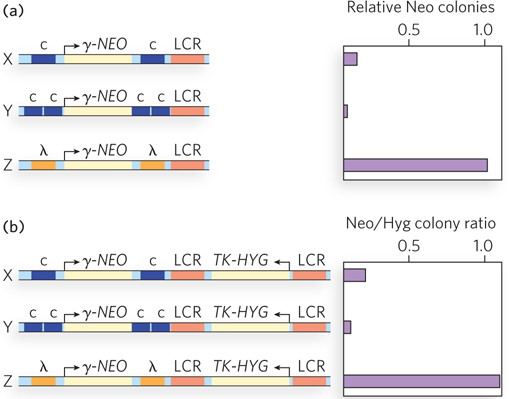DATA ANALYSIS PROBLEM
Chung, J.H., M. Whiteley, and G. Felsenfeld. 1993. A 5′ element of the chicken β-globin domain serves as an insulator in human erythroid cells and protects against position effect in Drosophila. Cell 74:505–
Question 21.12
By the early 1990s, a few examples of insulator sequences had been discovered and characterized in eukaryotic cells. These insulators were mostly found in Drosophila. To extend the work to vertebrates, Chung, Whitely, and Felsenfeld focused on features of the β-globin gene cluster that were conserved in chickens, mice, and humans. They noted that locus control regions (LCRs) near the 5′ end of the β-globin gene cluster served to attract enzymes that opened up the chromatin from the 5′ to the 3′ end of the cluster, a distance encompassing a few hundred thousand base pairs of the human genome. In principle, the LCR can serve that function—
756

What is a nuclease-
hypersensitive site in chromatin, and what is its significance?
The investigators constructed a series of vectors in which the constitutive hypersensitive region (denoted c in Figure 2) was placed at sites on either side of a gene conferring resistance to the antibiotic neomycin (γ-NEO in Figure 2). For eukaryotes, researchers generally use the related antibiotic geneticin, or G418, to kill cells. The γ-NEO gene confers resistance. The constructs are labeled X and Y in Figure 2. As a control, the investigators replaced the constitutive hypersensitive site (c) with a fairly random DNA segment of comparable length derived from λ phage (construct Z in Figure 2). They transfected human erythroleukemia cells with these constructs, isolated stably transfected cell lines (in which the construct had integrated at some random site in the genome), and counted the number of colonies produced when the cells were suspended in semisolid agar medium containing G418. As shown in the graph in Figure 2a, the number of G418-
The LCR generally controls genes on its 3′ side (to the right as shown in the figures). Why would it affect a neomycin-
resistance gene placed on the 5′ side?  FIGURE 2
FIGURE 2Why was it necessary to insert the hypersensitive sites on both sides of the neomycin-
resistance gene? Was the chicken hypersensitive site effective in isolating the neomycin-
resistance gene?
The investigators made a second series of constructs, shown in Figure 2b. Here, they added a gene for resistance to the antibiotic hygromycin (TK-
Why was this control experiment necessary?
Given the results presented above, can you conclude that the constitutive hypersensitive site from the chicken is an insulator that affects gene transcription? Justify your answer.
What other experiments would be needed to demonstrate or confirm that transcription was affected?